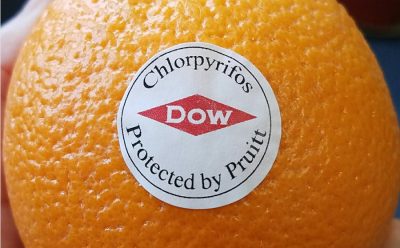The US 9th Circuit Court of Appeals ruled that the U.S. Environmental Protection Agency (EPA) has 60 days, from August 9th, to finalize a ban of the neurotoxic pesticide chlorpyrifos. The court’s decision overturned what was one of the first formal actions of the controversial former head of the EPA, Scott Pruitt, who chose to disregard years of his own agency’s research into the harmful effects of chlorpyrifos and overturn the proposal to ban the product.
Pruitt was forced to resign from the EPA in July after having been described as ‘easily the most corrupt senior official in the federal government’1 and questions had been raised concerning his connections to Dow Chemical and pesticide industry groups2.
“How did Mr. Pruitt reach the decision he announced on March 29, 2017? …did Mr. Pruitt have any communication with staff or representatives of Dow Chemical or any pesticide industry trade groups including CropLife America?”
Lawyers representing Dow and two other companies manufacturing the pesticides sent letters to the EPA, the Department of Commerce, and the Fish and Wildlife Service, asking them to ‘set aside’ the government studies claiming they were ‘fundamentally flawed’.
Pruitt claimed that: “By reversing the previous Administration’s steps to ban one of the most widely used pesticides in the world, we are returning to using sound science in decision-making – rather than predetermined results.”3
But, the appeals court concluded there was ‘no justification’ for overturning the proposed ban and that evidence of neurodevelopmental damage to children from chlorpyrifos residues in food is sufficient to support it.
Somewhat ominously, the EPA appears to be maintaining Pruitt’s stance and according to ‘Chemistry World’: “Agency spokesman Michael Abboud stated that the research data underlying the court’s assumptions are ‘inaccessible’, and this has hindered the EPA’s ongoing process to fully evaluate the pesticide with the best available science. Because of the dissenting opinion among the three-judge panel, the EPA might be able to appeal to the US Supreme Court.”4
Chlorpyrifos was developed by Dow Chemical, being introduced to the market in 1965, and the recently merged DowDuPont is now the leading manufacturer. Dow has always insisted that chlorpyrifos is safe, despite reports of acute poisoning and studies linking low-level exposures to children with lower IQ.
Most home use of the product was banned in the US in 2001, and the UK banned almost all uses in 2016. According to Dow AgroSciences chlorpyrifos is authorized for use in nearly 100 countries and applied to 8.5 million crop acres per year.5
“The company also has a long history — going back decades — of concealing from the public the many health problems it knew were linked to chlorpyrifos.
“In 1995, the EPA found that Dow had violated federal law by covering up its knowledge of these health problems for years. In 2004, then-New York Attorney General Elliot Spitzer found that Dow had been lying about the known dangers of the pesticide in its advertising for nearly as long. Together, the EPA and the State of New York have levied fines against the company approaching $3 million.”
Read more about the dangers of chlorpyrifos and the risk to children: The real dangers of GMOs Dow Chemical doesn’t want you to know about.
Dow Chemical Asks US Government Agencies to Ignore US Government Scientists’ Pesticide Study
1.Washington Post, 04 May, 2018: https://www.washingtonpost.com/blogs/plum-line/wp/2018/05/04/is-scott-pruitt-the-most-corrupt-member-of-the-trump-administration/?ncid=newsltushpmgnews__TheMorningEmail__070618&noredirect=on&utm_term=.d2505d477921
2.Letter from the United States Senate, Sen. Elizabeth Warren ad Rep, Frank Pallone, 27 April, 2017: https://www.warren.senate.gov/files/documents/2017_04_27_Letter_to_Pruitt_EPA.pdf
4. Chemistry World, 13 August, 2018. US government ordered to ban chlorpyrifos insecticide: https://www.chemistryworld.com/news/us-government-ordered-to-ban-chlorpyrifos-insecticide/3009370.article
5. Dow AgroSciences, Chlorpyrifos and Responsible Use: http://www.chlorpyrifos.com/benefits-and-use/use/responsible-use.htm



